Newborns & Babies Circumcision London
0-2 years
In many cultures and religious practices it is recommended to have boys circumcised soon after birth. At Circumcision Pro we are able to offer circumcisions soon after birth. At our CQC registered clinic our surgeons are extremely experienced in this age group. Above all we provide a safe and effective service and are always here to support parents and provide reassurance.
Preparation
Circumcision can be performed from 5 days after birth. At Circumcision Pro, we encourage parents to perform the circumcision as soon as possible after birth—a good time is between 2 to 4 weeks. This timeframe will allow a simpler procedure and, more importantly, a much shorter recovery period. In addition, the psychological stress endured by babies is much less than when they are older.
Emotional preparation for parents is extremely important as this can have an influence on the baby’s experience of the procedure. First and foremost, it is extremely important that both parents are happy to go ahead with their son’s circumcision and that they are happy with the timing. Any disagreement regarding going ahead with the procedure will be a flashpoint before, during and after the procedure and can potentially have a negative impact on the whole experience.
This is especially important in mixed-race families where the practice of circumcision is alien to one of the parents. Ensure that you have discussed the procedure amongst yourselves and you are both fully committed to going ahead with it. At Circumcision Pro, we are very keen to ensure that both parents are comfortable with the consent process. If we feel that either parent is uncomfortable then we will not proceed with the circumcision.
The Procedure
In newborns, babies and young infants, we use the ‘ring’ method. This is the recommended ‘gold standard’. This involves the use of a plastic ring as opposed to the traditional cut and stitch.
There are two types of ring device – the Plastibell Ring and the Circumplast Ring. The technique used in both types of ring is the same.
With experience in all methods of circumcision, we can adapt to each client’s needs. Our preference is to use the Plastibell ring. However, where the penis is found to be slightly ‘buried’ we prefer to use the Circumplast ring.
A ‘buried’ penis is when the penis is partially or completely hidden within the fat of the lower part of the abdomen. Size is often normal. This condition is relatively common and can make it difficult to perform the circumcision. Where the penis is significantly buried, we often recommend the circumcision is delayed until your son is much older – often at least 2 years old. We will carry out a thorough examination prior to performing the circumcision and will advise you accordingly.
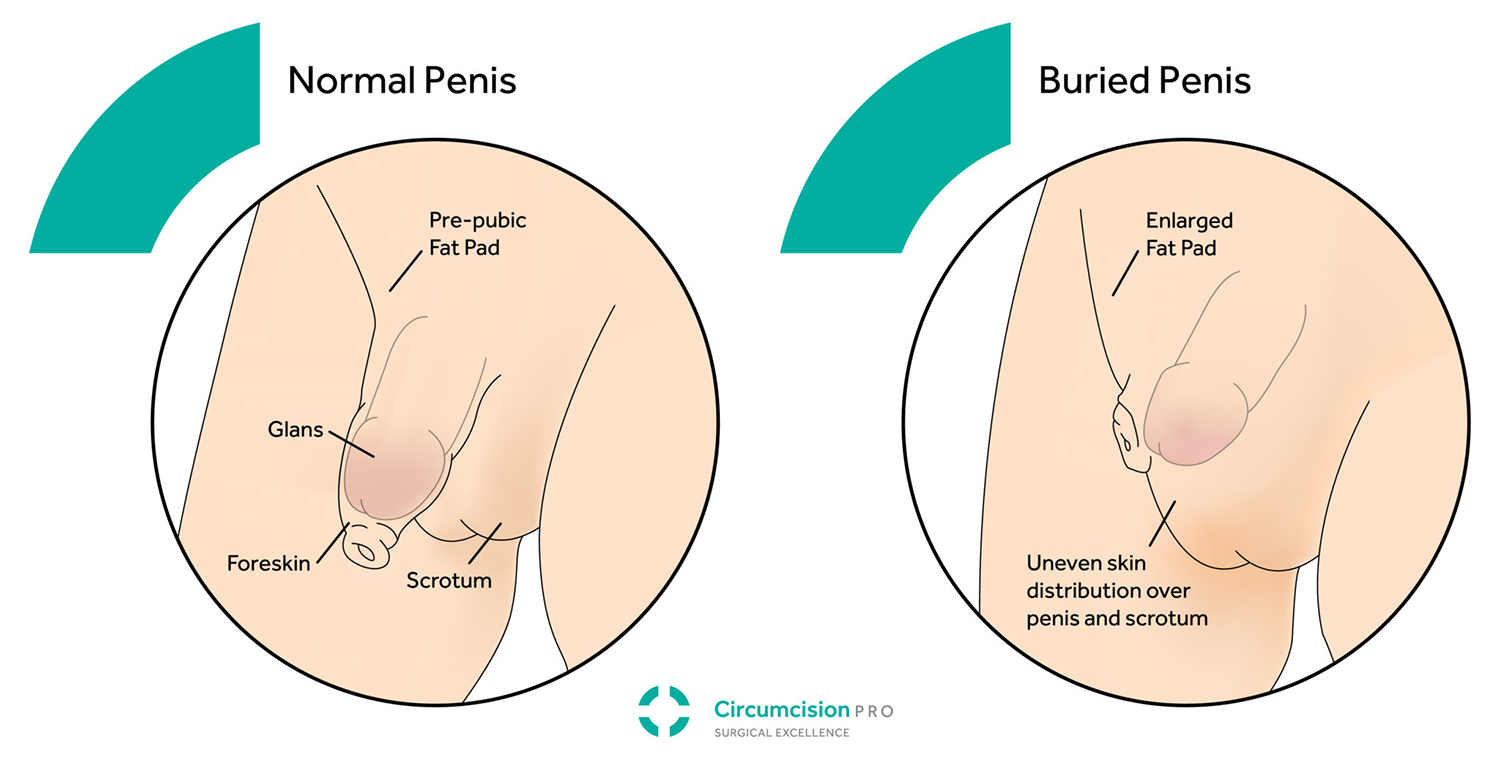
- The penis is numbed using a local anaesthetic injection into the base of the penis.
- The foreskin is stretched and retracted to reveal the head of the penis.
- We then clear any adhesions and usually separate what is known as the frenulum from the base of the penile head. There can be some minor bleeding at this point. We will usually use a cauterisation device to stop any bleeding and proceed to size the ring.
- The Plastibell ring comes in a variety of sizes. After selecting the appropriate size, the ring is passed over the head of the penis.
- The retracted foreskin is pulled back over the ring.
- A tight suture (string) is tied against the ring trapping the foreskin.
- The foreskin is trimmed back to the edge of the ring.
- Any bleeding edges are cauterised.
- Over the course of the next 7 to 8 days, the thread will cut through the foreskin.
- Subsequently, the foreskin and ring will drop off revealing a fully circumcised penis. The process is similar to the umbilical cord falling off soon after birth.
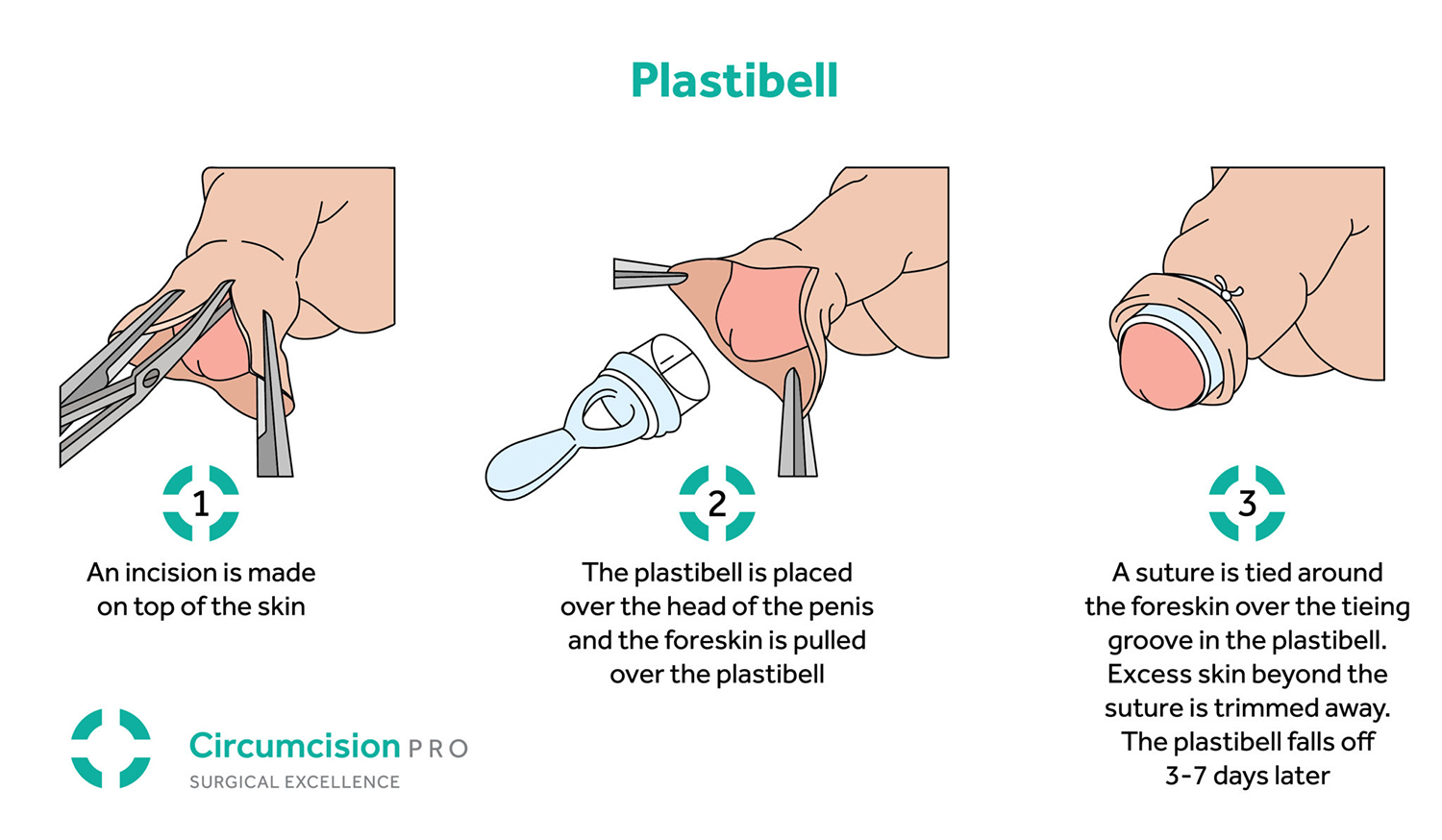
A circumplast circumcision is almost identical to the plastibell method. The major difference is that the circumplast ring is a slightly different shape and is better suited to boys who have a mild to moderate buried penis.
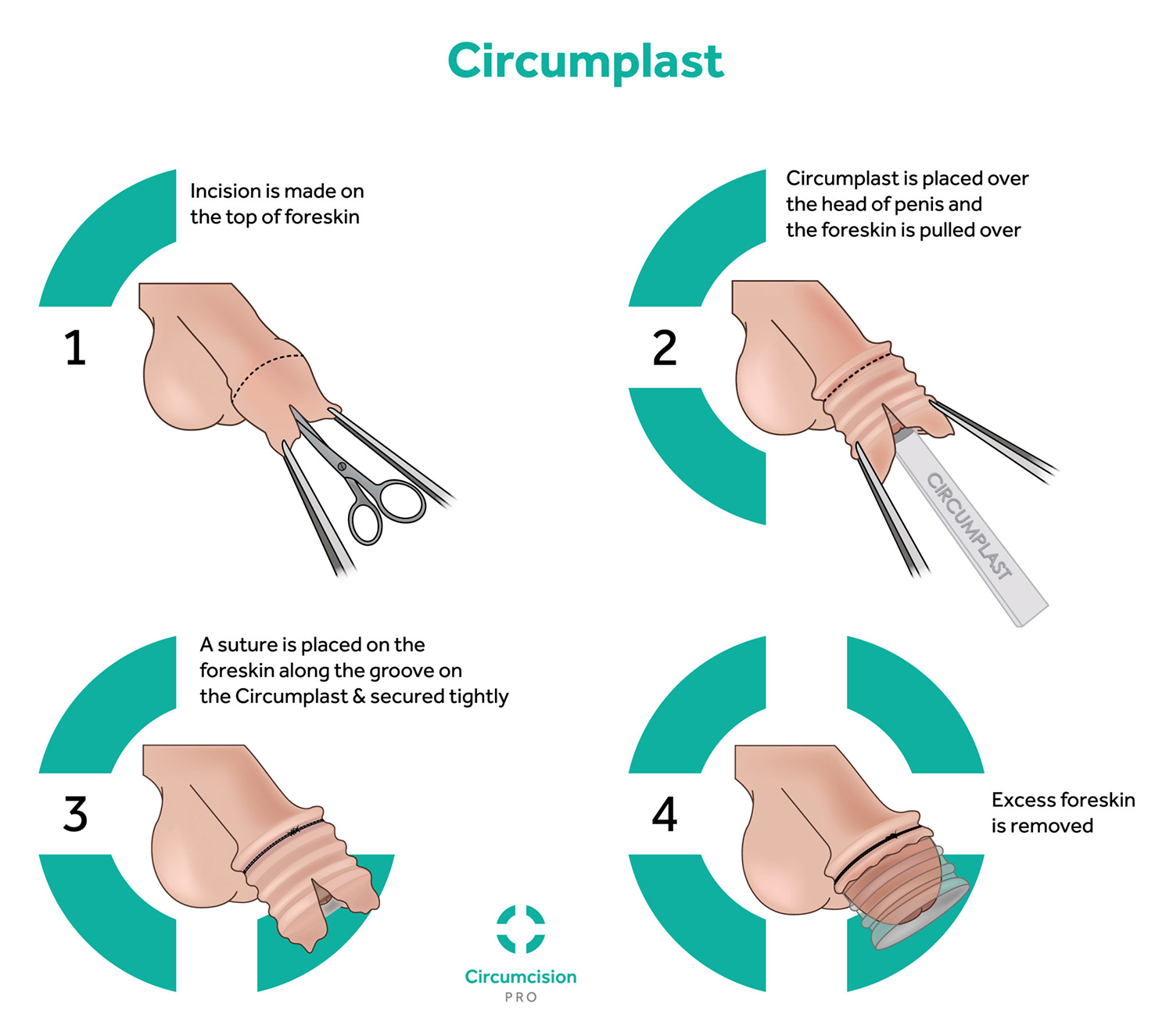
In rare circumstances, the ‘ring’ method may not be appropriate, whether it be the plastibell or circumplast rings. Both types of rings are produced in a variety of sizes to fit over different sizes of penis. If the penile girth is quite large it is possible that the plastibell and/or circumplast ring may not fit. In this case, it may be necessary to opt for a traditional ‘cut and stitch’ approach. Often, this approach is not suitable for babies below the age of 6 months and we may recommend delaying the procedure until your son is a little older. This is because a traditional ‘cut and stitch’ technique is slightly more difficult and takes longer to perform.
On The Day
Consultation
On the day, we will first explain the procedure and discuss any potential complications. Then, we will go through the details of the immediate aftercare and provide contact details should you have any further questions once you get home. You will have our support through every step of the process.
We will require consent for all procedures. To gain consent for a procedure to be carried out on your son, it is necessary that both parents are present on the day. They must be in complete agreement with regards to going ahead. Both parents must sign the consent form. If one or both parents are not able to be present, a signed consent letter will be required alongside proof of signature. Single mothers must demonstrate full custody and parental rights if they are the sole parent. In the case of single fathers, we will require some form of documentation to confirm that the mother has given consent or that court approval has been granted.
The circumcision process consists of two steps. Initially, babies and infants are given a local anaesthetic block that will numb the entire penis to ensure a painless procedure. Unlike a general anaesthetic, the medication will not put the child to sleep. Administration of the local anaesthetic can be painful. It involves three small injections at the base of the penis. This will sting a little and it is normal for babies and infants to cry at this point. The injections are very quick and should take no longer than 30 to 45 seconds. The local anaesthetic used is a mixture of short-acting and long-acting anaesthetic which takes effect within about 5 to 6 minutes and lasts for at least 1 hour.
This will easily cover the duration of the circumcision and part of your journey back home. Prior to commencing the procedure, we will check and demonstrate to the parents that the anaesthetic is working and the entire penis is completely numb.
Once we have completed the circumcision we will ask you to remain in the clinic for a further 15 to 20 minutes so that we can check to ensure there is no bleeding and that the baby is settled. We will also answer any final questions and concerns you may have. You will be given access to our 24/7 aftercare service, allowing you to return home with your minds at ease.
Although the ‘Plastibell’ ring is considered the gold standard there are times when it may not be appropriate. In certain circumstances, we may choose to use the ‘Circumplast’ ring instead. This is normally when your son has a ‘buried’ penis. A buried penis is where a large amount of pelvic fat sits just behind the base of the penis and gives the illusion of the penis being shorter in length than it actually is. The result is that it is partially or completely hidden below the surface of the skin.
In much rarer situations, both Plastibell and Circumplast methods may be unsuitable. This is usually because the penis is extremely well developed and has a much larger girth than can be accommodated by the Plastibell or Circumplast rings. In this case, a traditional cut and stitch technique will be considered. Please note that often in newborns and babies less than 6 months this technique is not possible and our surgeon may recommend delaying the circumcision.
Another condition that can result in the procedure getting cancelled is called Hypospadias. This is when the opening to the urethra (where urine exits from) is not at the tip of the head of the penis but instead is running along the base of the head of the penis and in some cases the shaft. In this case, we will instruct your GP to refer your son to a paediatric urologist.
Please note that it is sometimes difficult to diagnose hypospadias until we have actually stretched and retracted the foreskin. We always perform this part of the procedure without cutting any skin just in case we have to stop the procedure in the event of finding hypospadias.
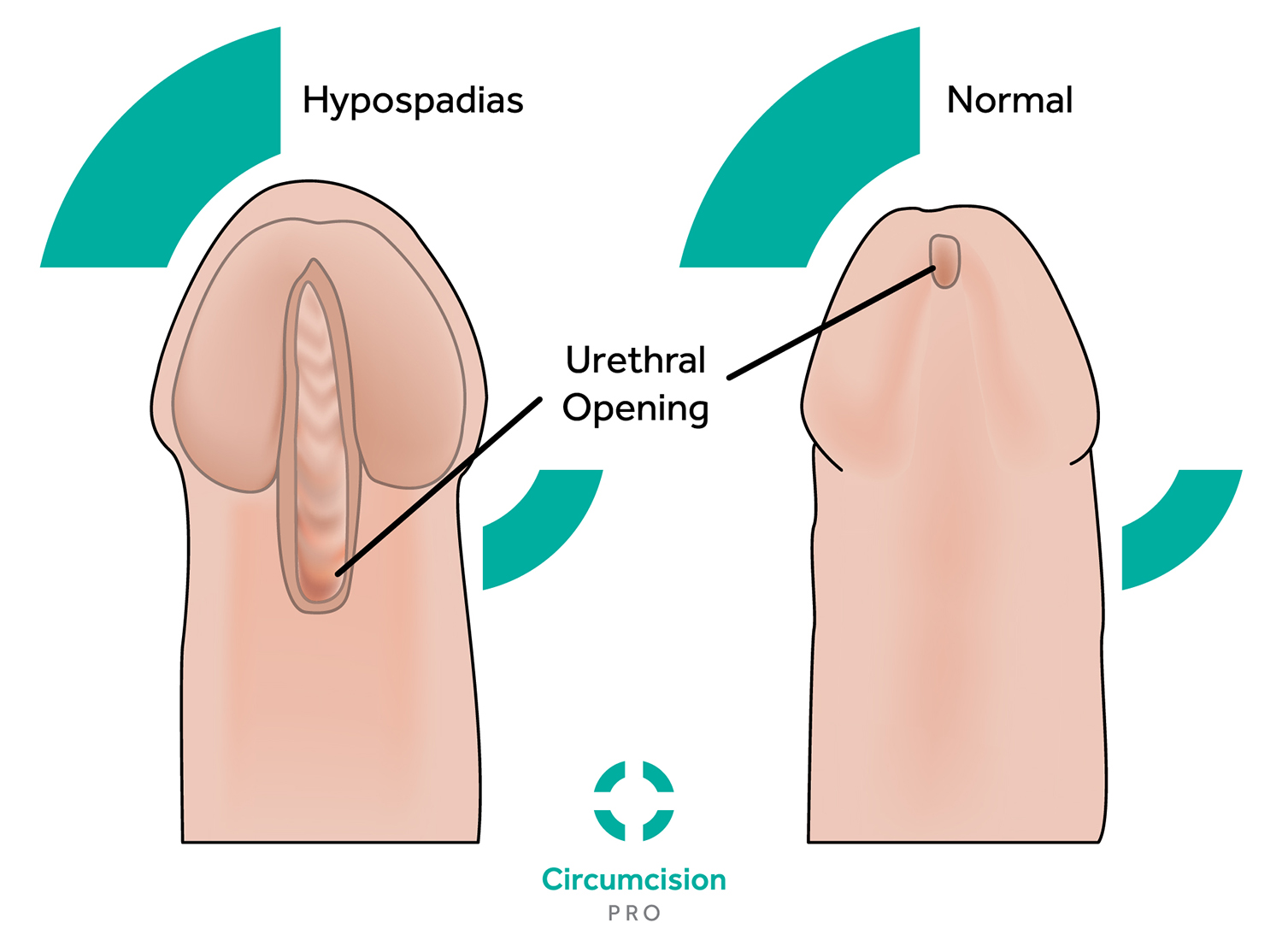
A scrotal web is normally a congenital condition where the skin of the scrotum extends onto the skin of the shaft of the penis. As a result the head and shaft of the penis can effectively be stuck to the scrotum. This means there is not enough skin on the underside of the penis to be able to complete the circumcision safely. If this is identified our surgeon will cancel the procedure and arrange for your son to be referred back to your GP. Your GP will need to refer your son to a urologist or plastic surgeon to perform a procedure to release the scrotal web.
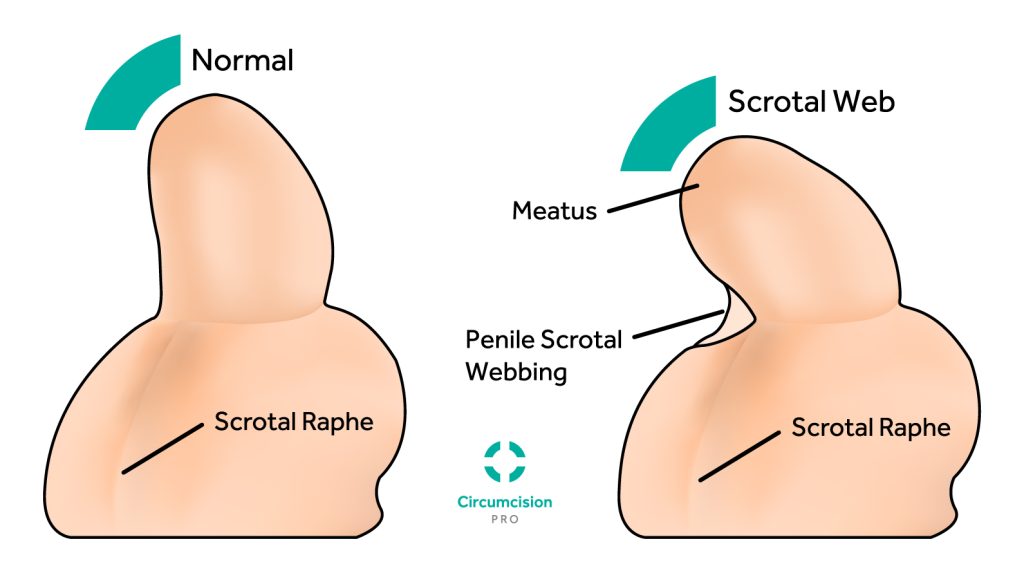
The Aftercare
After Care for Plastibell & Circumplast

After Care for Plastibell & Circumplast
Antibiotic Ointment
Apply 3 times a day every day till the ring falls off
Salt Water Bath
Start on day 2 post op and continue every day till ring falls off
Regular Nappy Changes
Change nappies regularly. Use the same size.
Babies below the age of 2 months should not be given any paracetamol or ibuprofen. For those aged above the age of 2 months, an age-appropriate dose of paracetamol or ibuprofen can be administered. Most infants will be slightly unsettled for the first 24 hours. The best thing to do is to remain calm and ensure the baby is well-nourished with food and attention.
After the circumcision, we will normally apply a single piece of gauze covering the operative site. Once your son has had a wet nappy this piece of gauze can be removed and does not need to be replaced. We will keep you at the clinic for 20 minutes after the procedure to ensure there is no bleeding and it is important to keep an eye out for the first 6 to 12 hours after the procedure.
It is normal to have a slight ooze on the first day. However, if your son continues to bleed beyond 6 hours and/or has a bloodstain larger than a 50 pence coin, please contact the clinic at any time of the day. If in any doubt do not hesitate to call the clinic.
After the operation, your son’s whole penis may be swollen and look slightly bruised. This is a normal effect of both the local anaesthetic injection and the placement of the ring. This will gradually reduce over the next few days.
After leaving the clinic please pick up an antibiotic ointment from your local pharmacy. You need to apply this to the wound site three times a day until the ring falls off. Regular application of the ointment (antibiotic cream) will help to prevent infection and will soften the skin to help the ring fall off quicker.
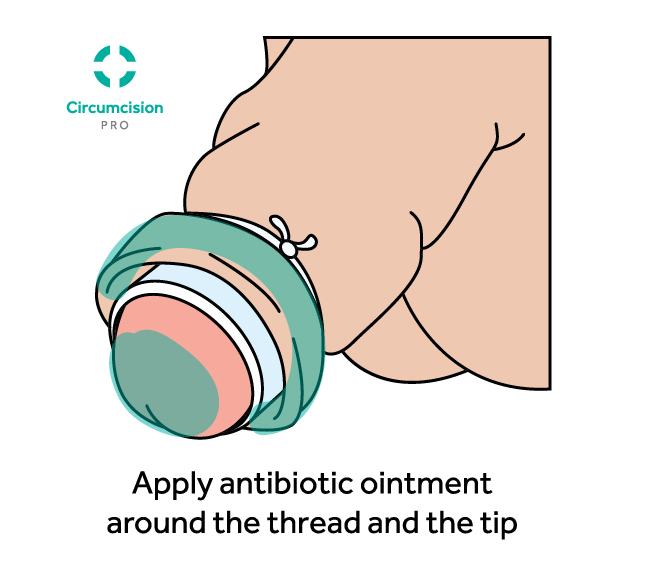
We advise parents to use the same size nappies they normally do. There is no need to use looser nappies. We advise that you only use disposable nappies until the ring has fallen off. Check your baby’s nappy area regularly and change the nappy at the earliest opportunity if wet or dirty. You can continue to use wet wipes but avoid applying any barrier creams to the circumcision site. A smearing of petroleum jelly, e.g. Vaseline or Olive oil around the ring site will prevent his penis sticking to the nappy.
Avoid bathing on the first day but bathe him thereafter at least once a day until the ring comes off. Bathe your son in a small bath of warm water and add between a quarter and a half tablespoon of salt to the bath. Submerge your baby’s penis in the salt bath for 3 to 4 minutes. Avoid any soaps or detergents.
There is a common misconception amongst parents that their babies will struggle to pass urine once the ring is on. This is absolutely not the case. Your son should be able to pass urine normally with the ring in place. We advise parents to ensure they have observed their children having a wet nappy within the first 6 hours after the procedure has been completed.
If an infection is to occur, signs are unlikely to be visible until the 3rd or 4th day after the circumcision. You need to look out for evidence of increasing swelling, increasing redness, any discharge from the wound and/or if he develops a fever or appears to be in more pain then he was previously.
If you are concerned about infection, please call the clinic. If we feel that there is evidence of infection we will prescribe antibiotics for your son. For any concerns you have regarding your son’s circumcision it is essential that you contact us without hesitation.
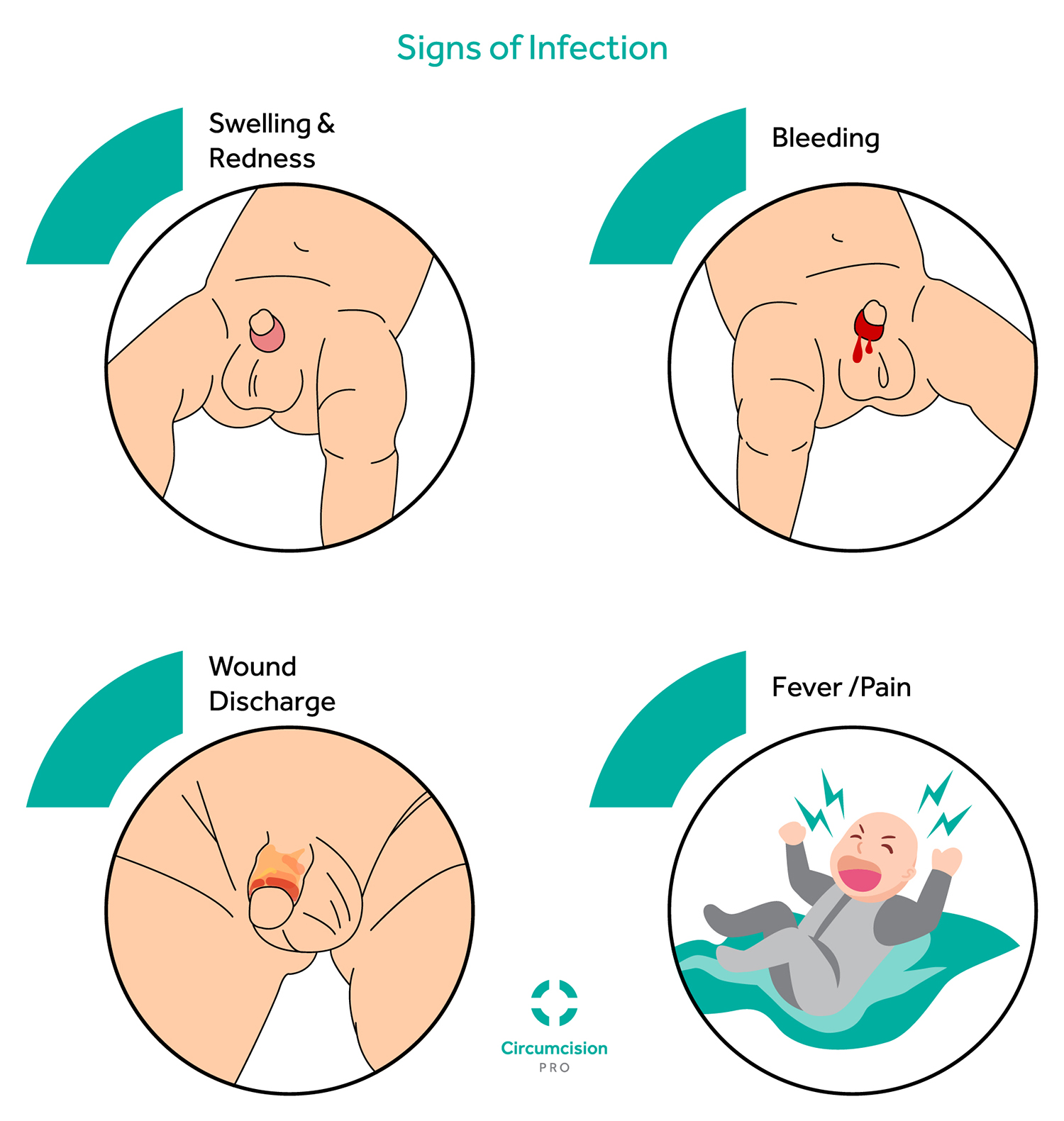
The ring is likely to fall off within 6 to 7 days after the procedure, however, it is not unusual for the ring to take up to 10 days to fall off. In the rare instance that the ring does not fall off within 10 days after the circumcision, please inform the clinic as it may be necessary to manually remove the ring.
Please do not interfere with the circumcision site other than to make sure it is kept clean. A dark brown or black area around the plastic ring is perfectly natural and will disappear after the ring has fallen off. The skin under the string may also become soft and yellow, like the umbilical cord stump. There may be a little pink or red staining of the nappy for a few hours after the circumcision and again when the ring separates. Do not attempt to pull it off, even if it seems loose.
Once the ring has fallen off the circumcision site should heal up within another 7 to 10 days. After the area has healed, it is good practice to push back what remains of the foreskin and put a generous amount of vaseline around the groove of the penis. Repeating this at every nappy change will ensure the edge of the cut foreskin does not start to stick back to the head and form adhesions. If adhesions do develop, you will need to bring your son back to the clinic to have them released.
FAQ's about your Baby
As specified earlier, the process of injecting the local anaesthetic is painful and will sting and at this point, all babies and infants will cry. However, once this has set in the entire penis will be numb. It is extremely rare for the anaesthetic not to work. Our surgeons are very experienced and able to administer excellent anaesthesia. However, this does not guarantee your son will not cry during the procedure. Some children still cry during the procedure and this is usually because they become frustrated at their nappies being opened and legs being held. They will not feel any pain and there is no reason to be alarmed.
It is completely normal to feel nervous and anxious. Seeing your newborn son going through a procedure can be a stressful experience and parents deal with this in different ways. The most important thing to remember is that the stress of parents can spread to their children. Even the youngest of infants look to their mothers to determine how to react to a situation. The best way to help your son through this process is to remain calm yourselves. From our experience of over 6000 circumcisions, we have noticed that agitated parents go hand in hand with crying babies. Numerous studies have demonstrated a link between maternal anxiety and excessive infant crying. The best way to ease the process for your son is to try and be as relaxed as possible.
This depends on age, with recovery times increasing the older the child gets. Typically for infants the ring and excess foreskin come off within 5 to 10 days and the area will usually heal completely after another 1 to 2 weeks.
If the suture method has been used, then recovery times are usually 4 to 6 weeks.
There is a common misconception amongst parents that their babies will struggle to pass urine once the ring is on. This is absolutely not the case. Your son should be able to pass urine normally with the ring in place. We advise parents to ensure they have observed their children having a wet nappy within the first 6 hours after the procedure has been completed.
We do not routinely prescribe antibiotics after the procedure. We do, however, prescribe you an antibiotic cream to apply to the wound 3 times a day in the week following the procedure.
At Circumcision Pro, we believe our clients are clients for life and we are always on hand to help answer your questions and address your concerns. At the initial consultation, we will go through the entire aftercare process with you. We will also provide you with a comprehensive pack consisting of relevant prescriptions, a summary sheet of the aftercare instructions, a letter to be handed into your son’s GP stating what specific procedure has been performed as well as our 24/7 contact details.








